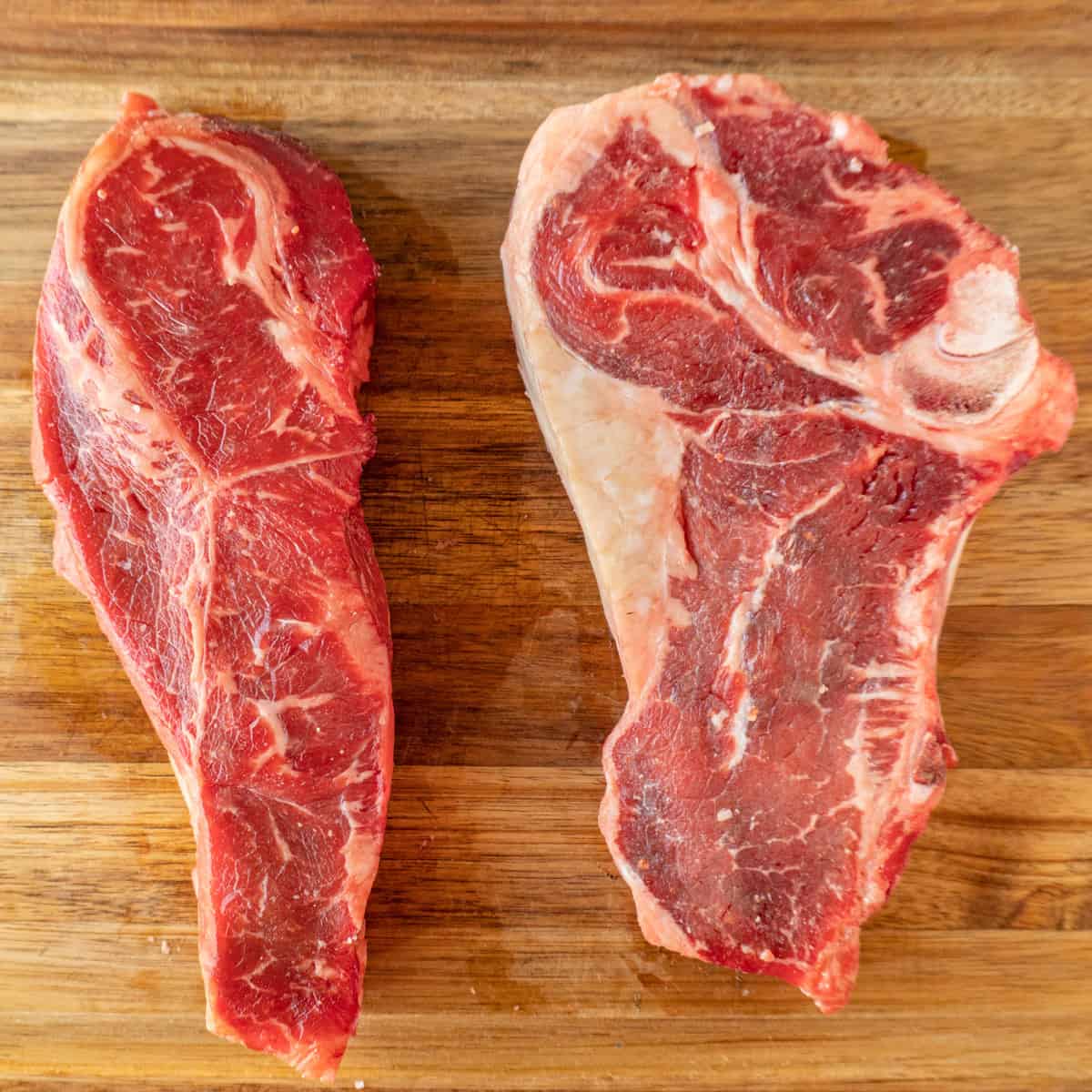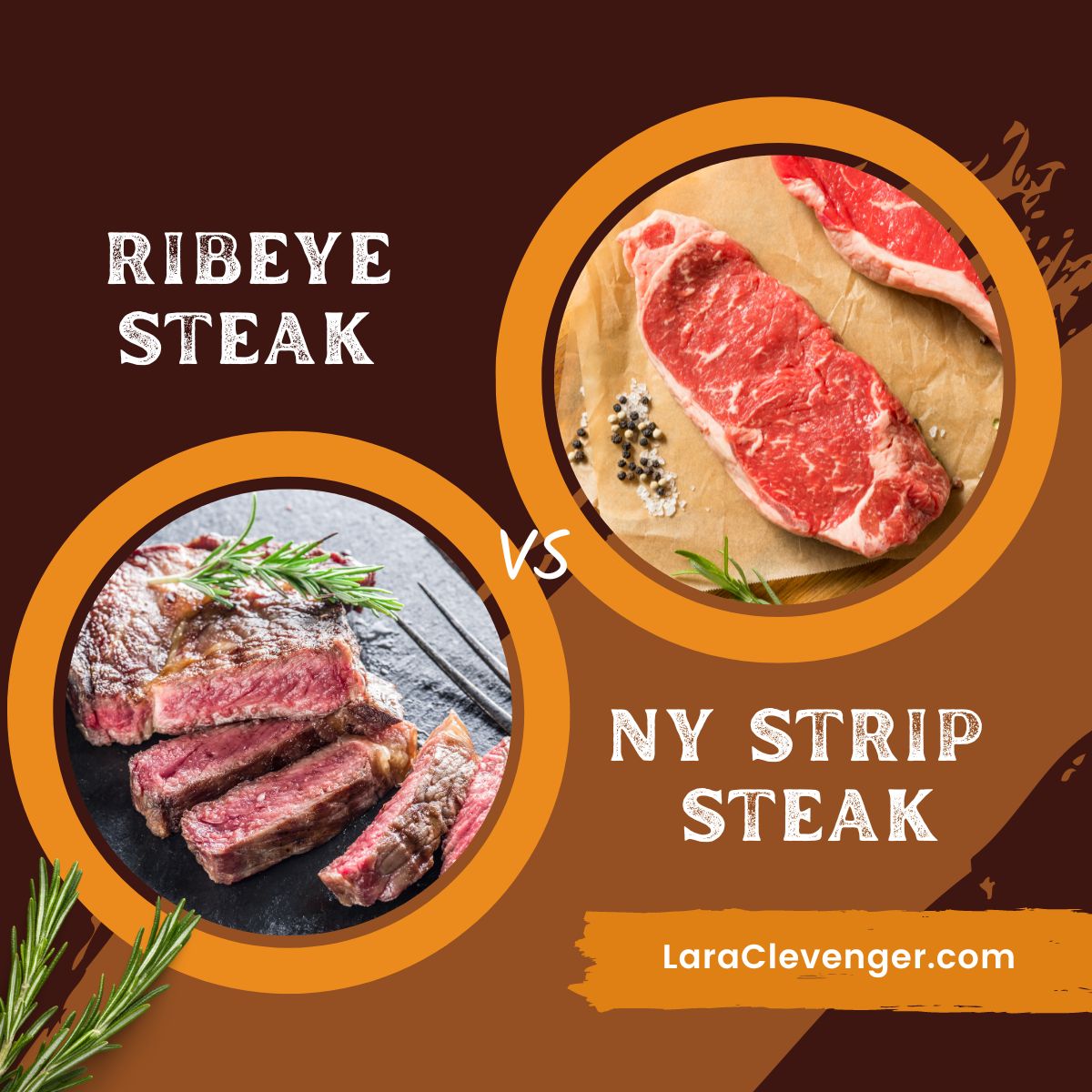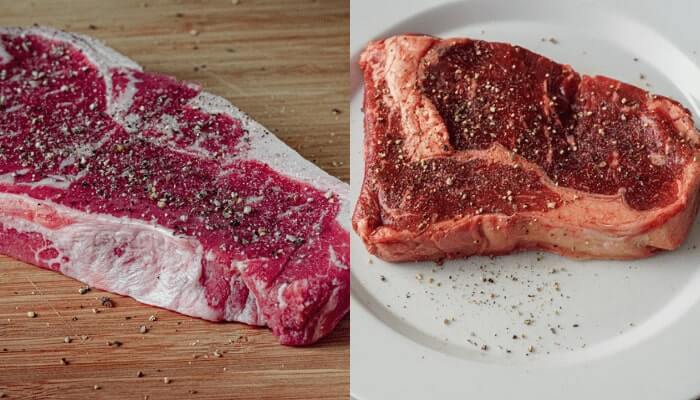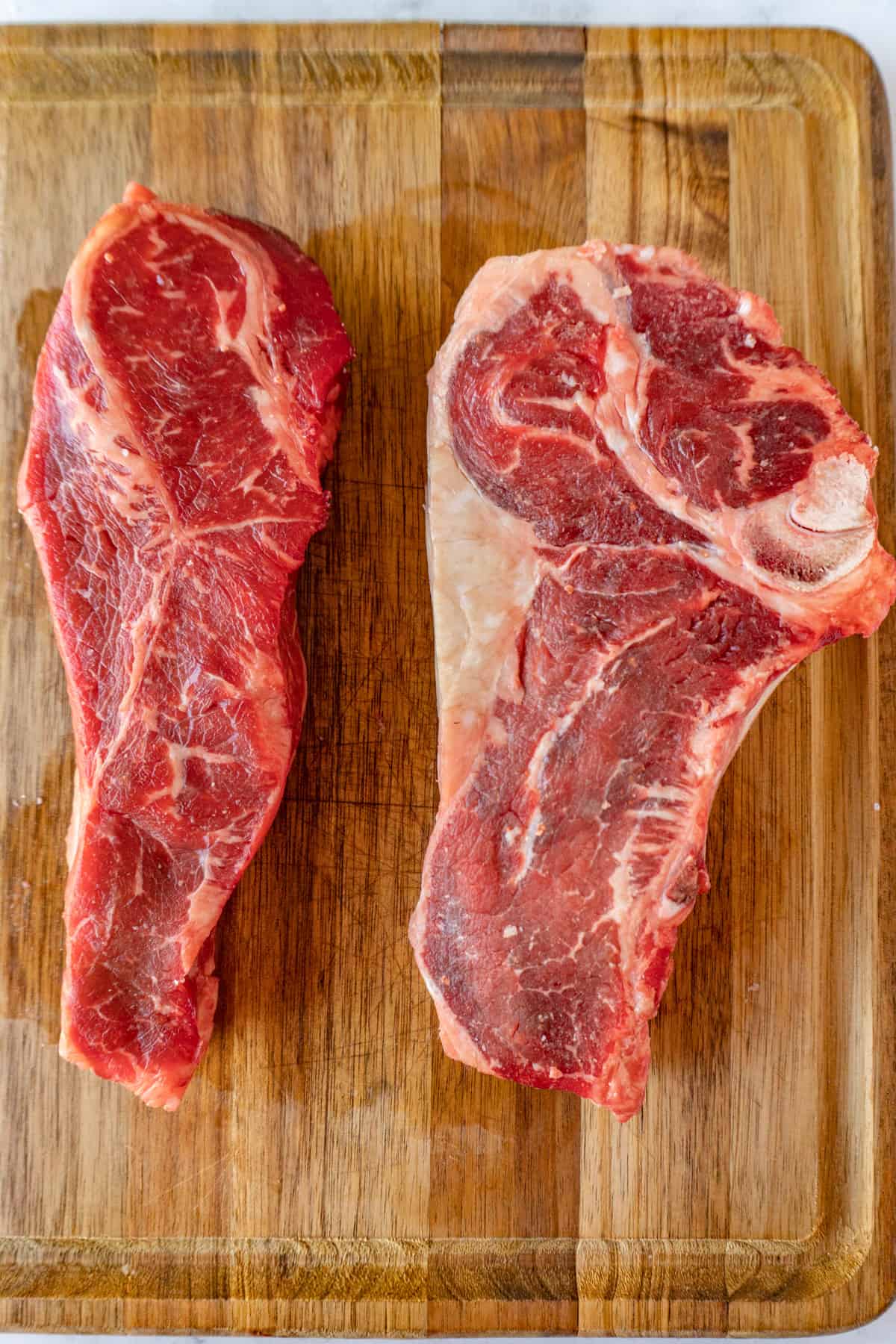Introduction

In the world of steaks, two cuts stand out for their exceptional flavor and tenderness – the New York strip and the ribeye. These cuts have been the subject of debate among meat lovers for years, as each has its own unique qualities. The New York strip is known for its lean and tender meat, while the ribeye offers a juicy and flavorful experience. In this article, we will explore the differences between these two steaks, their flavor profiles, cooking techniques, and help you make an informed decision based on your personal preferences. So let’s dive into the New York strip vs ribeye steak showdown!
Comparison Between New York Strip And Ribeye
When it comes to comparing the New York Strip and Ribeye steaks, there are several key differences to consider. While both cuts offer exceptional flavor and tenderness, they differ in terms of fat distribution and texture. The New York Strip is known for its lean and tender meat, with a slightly firmer texture. On the other hand, the Ribeye steak is renowned for its marbling, which contributes to its juiciness and exceptional tenderness. These distinctions make each cut unique in its own way and cater to different preferences.
Different Cuts, Flavors, And Textures
When it comes to different cuts, flavors, and textures, the New York Strip and Ribeye steaks have their own unique qualities. The New York Strip, also known as the Striploin or the Kansas City strip, is a lean cut with minimal marbling. It is known for its firm texture and a robust beefy flavor. On the other hand, the Ribeye steak, with its abundant marbling, offers a melt-in-your-mouth tenderness and a rich, buttery flavor. The marbling in the Ribeye adds juiciness and enhances the overall flavor profile. So, whether you prefer a leaner, firmer texture or a tender, juicy steak, both cuts have something to offer.
New York Strip Steak

New York Strip Steak, also known as Striploin or Kansas City strip, is a popular cut of beef known for its firm texture and robust flavor. It is a lean steak with minimal marbling, making it a healthier option. The New York Strip is best cooked using dry heat methods such as grilling or broiling to preserve its tenderness. It is often served with a side of vegetables or mashed potatoes. The New York Strip Steak is a favorite among steak enthusiasts for its balanced flavors and protein-rich profile.
New York Strip Steak
New York Strip Steak, also known as Striploin or Kansas City strip, is a popular cut of beef known for its firm texture and robust flavor. It is a lean steak with minimal marbling, making it a healthier option. The New York Strip is best cooked using dry heat methods such as grilling or broiling to preserve its tenderness. It is often served with a side of vegetables or mashed potatoes. The New York Strip Steak is a favorite among steak enthusiasts for its balanced flavors and protein-rich profile.
Flavor Profile And Tenderness
The New York Strip Steak has a balanced and robust flavor profile. It offers a slightly more subtle taste compared to the Ribeye, making it a popular choice for those who prefer a milder steak. The New York Strip Steak is known for its firm texture and tenderness, making it enjoyable to bite into. On the other hand, the Ribeye Steak is celebrated for its rich, buttery flavor and exceptional tenderness due to its high marbling content. It melts in your mouth and is often considered the epitome of juiciness.
Cooking Techniques For New York Strip Steak

When it comes to cooking the New York Strip Steak, there are several techniques that can bring out its best flavors and ensure a tender and juicy result. Here are some popular methods for cooking the New York Strip Steak:
- Grilling: The New York Strip is well-suited for grilling. Preheat the grill to high heat and sear the steak for a few minutes on each side. This will create a delicious charred crust while preserving the steak’s juicy interior.
- Searing: Heat a cast-iron skillet or grill pan over high heat and sear the steak for a few minutes on each side. Once seared, transfer the steak to the oven to finish cooking to your desired level of doneness.
- Broiling: Preheat the broiler and place the steak on a broiler pan. Cook the steak for a few minutes on each side, keeping a close eye on it to prevent overcooking. This method creates a nice crust while maintaining the steak’s juiciness.
- Sous Vide: Sous vide cooking involves vacuum-sealing the steak and cooking it in a water bath at a precise temperature. This method ensures even cooking and consistent tenderness throughout the steak. Finish the steak by searing it briefly to add a crispy exterior.
Remember to let the steak rest for a few minutes before slicing and serving. This allows the juices to redistribute, resulting in a more flavorful and tender steak. Enjoy your perfectly cooked New York Strip Steak!
Ribeye Steak
Ribeye Steak is a popular cut that is known for its exceptional tenderness and rich marbling. It is highly sought after by steak aficionados for its juiciness and melt-in-your-mouth texture. The marbling, which refers to the intramuscular fat that runs throughout the meat, adds a luxurious flavor and succulence to the steak. Ribeye can be cooked using various techniques such as grilling, pan-searing, or broiling to enhance its natural flavors. The result is a beautifully marbled steak that is tender, juicy, and full of flavor.
Ribeye Steak
Ribeye Steak is renowned for its exceptional tenderness and rich marbling, making it a favorite among steak enthusiasts. The marbling, which refers to the intramuscular fat running throughout the meat, lends the steak a luxurious flavor and succulence. Whether grilled, pan-seared, or broiled, Ribeye Steak delivers a melt-in-your-mouth texture and a juicy, flavorful experience. Its high fat content adds to the richness and depth of taste, making it an indulgent choice for steak lovers. When cooked to perfection, Ribeye Steak offers a tender and mouthwatering dining experience.
Marbling And Juiciness

One of the distinguishing features of Ribeye Steak is its abundant marbling, which refers to the fine threads of intramuscular fat running throughout the meat. This marbling is what gives the Ribeye its exceptional tenderness, juiciness, and rich flavor. As the steak cooks, the marbling melts, infusing the meat with a luxurious and buttery essence. This marbled fat also helps to keep the steak moist and succulent, ensuring a melt-in-your-mouth experience bite after bite. The delicious combination of marbling and juiciness sets Ribeye Steak apart and makes it a beloved choice for steak lovers.
Best Ways To Cook Ribeye Steak
There are several ways to cook a delicious Ribeye steak. One popular method is to grill it. Start by preheating the grill to high heat. Season the steak with salt and pepper, and then place it on the hot grill. Cook for about 4-5 minutes on each side, or until the desired level of doneness is reached. Another option is pan-searing. Heat a cast-iron skillet over high heat, add some oil, and then sear the steak for a few minutes on each side. Finish it off in the oven for a perfectly cooked Ribeye steak. Lastly, you can also broil it in the oven. Place the steak on a broiler pan and position it about 4 inches away from the heat source. Cook for about 4-6 minutes on each side, depending on the thickness of the steak. Whichever method you choose, be sure to let the steak rest for a few minutes before slicing and serving.
Key Differences
When comparing New York Strip and Ribeye, there are key differences that steak enthusiasts should consider. In terms of taste, the New York Strip offers a balanced flavor with lean meat, making it a budget-friendly option. On the other hand, Ribeye steak is known for its exceptional marbling, resulting in a juicier and more flavorful experience. When it comes to tenderness, the Ribeye usually takes the lead with its higher fat content. Ultimately, the choice between these two cuts depends on personal preferences and cooking styles. By understanding these key differences, individuals can make informed choices to suit their tastes and preferences.
Comparing New York Strip And Ribeye In Terms Of Taste

When comparing New York Strip and Ribeye steaks in terms of taste, it becomes evident that they offer different flavor profiles. The New York Strip, with its leaner meat, provides a balanced flavor that is not overly rich. On the other hand, the Ribeye’s exceptional marbling results in a more intense, juicy, and flavorful experience. The higher fat content in the Ribeye contributes to a buttery and succulent taste. Ultimately, the choice between these two cuts depends on personal preferences and the desired taste experience.
Identifying The Variations In Tenderness
When it comes to tenderness, both the New York Strip and Ribeye steaks have their own unique characteristics. The New York Strip is known for its firm texture and slightly chewy bite. It offers a good balance between tenderness and meatiness. On the other hand, the Ribeye steak takes tenderness to another level. With its abundant marbling, it practically melts in your mouth, providing a buttery and tender experience with every bite. Whether you prefer a satisfying chew or a melt-in-your-mouth tenderness, both steaks offer variations in tenderness to suit different preferences.
Choosing The Right Cut
When it comes to choosing between the New York Strip and Ribeye steak, there are a few factors to consider. First and foremost, it comes down to personal preference. Do you prefer a firmer, slightly chewy bite or a melt-in-your-mouth tenderness? Additionally, consider your cooking style. If you like to use high-heat cooking methods like grilling or broiling, the Ribeye, with its marbling and juiciness, may be the better choice. However, if you prefer a more balanced flavor and texture, the New York Strip is a great option. Ultimately, the choice between these two cuts comes down to individual taste and cooking preferences.
Factors To Consider When Deciding Between New York Strip And Ribeye

When choosing between the New York Strip and Ribeye, there are a few factors to consider. First, think about your personal preferences. Do you prefer a firmer, slightly chewy bite or a melt-in-your-mouth tenderness? Next, consider your cooking style. If you like high-heat cooking methods like grilling or broiling, the Ribeye’s marbling and juiciness may be the better choice. On the other hand, if you prefer a more balanced flavor and texture, the New York Strip is a great option. Ultimately, it comes down to individual taste and cooking preferences.
Personal Preferences And Cooking Styles
When choosing between the New York Strip and Ribeye, personal preferences and cooking styles play a crucial role. Some individuals prefer the tender and melt-in-your-mouth texture of the Ribeye, while others enjoy the firmer, slightly chewy bite of the New York Strip. Cooking techniques also come into play, as the Ribeye’s marbling and juiciness make it ideal for high-heat methods like grilling or broiling. On the other hand, the New York Strip offers a more balanced flavor and texture, making it suitable for various cooking styles such as pan-searing or oven-roasting. Ultimately, it is important to consider individual tastes and cooking preferences when making a decision.
Conclusion
In conclusion, the debate between the New York Strip and Ribeye steak is a flavorful adventure for meat lovers. Both cuts have their own unique qualities that appeal to different palates. The New York Strip offers a balance of flavor and lean meat, making it a cost-effective choice. On the other hand, the Ribeye is known for its exceptional tenderness and marbling, making it a more coveted and slightly pricier option. Ultimately, choosing between the two comes down to personal preferences and cooking styles. Whether grilling or pan-searing, both cuts are sure to satisfy any carnivorous craving.
Summary Of The New York Strip Vs Ribeye Comparison

The comparison between the New York Strip and Ribeye reveals distinct differences in flavor, tenderness, and texture. The New York Strip offers a balance of lean meat and marbling, providing a cost-effective option for those seeking flavor and protein. On the other hand, the Ribeye stands out with its exceptional tenderness and abundant marbling, making it a more sought-after choice. Ultimately, the decision between the two cuts comes down to personal preferences and cooking styles. Both steaks are sure to satisfy meat lovers with their unique qualities.
Making Informed Choices According To Individual Tastes And Preferences.
When it comes to choosing between a New York Strip and a Ribeye, making an informed decision is crucial. Personal tastes and preferences play a significant role in this choice. Some people may prefer the leaner and slightly milder flavor of the New York Strip, while others may enjoy the rich marbling and juiciness of the Ribeye. It’s important to consider your cooking style, desired tenderness, and desired level of flavor when making a decision. Ultimately, choosing between the New York Strip and Ribeye will depend on what satisfies your palate and culinary preferences.
FAQ: New York Strip vs Ribeye
Q: What is the difference between a New York Strip and a Ribeye?
A: The main difference between a New York Strip and a Ribeye lies in their location on the cow and the amount of marbling in the meat. While both cuts are flavorful and tender, they have distinct characteristics that set them apart.
Q: Where does each cut come from?
A: A New York Strip, sometimes known as a strip steak or shell steak, is cut from the short loin of the cow. On the other hand, a Ribeye is taken from the rib area, specifically the sixth through twelfth ribs.
Q: What is the texture and tenderness like for each cut?
A: The New York Strip is known for its firm texture and slightly leaner composition compared to a Ribeye. It offers a satisfying bite with a good balance between tenderness and chew. In contrast, the Ribeye is often more tender and succulent due to its higher fat content, resulting in a buttery and melt-in-your-mouth experience.
Q: What about the flavor profiles?
A: A New York Strip offers a robust, beefy flavor with a hint of sweetness. Its moderate marbling enhances the taste, while the lack of excessive fat keeps the focus on the meat itself. Conversely, a Ribeye has a remarkably rich and intense flavor, thanks to its generous marbling throughout the steak. The marbling contributes to the infamous “beefy” and buttery taste that Ribeyes are known for.
Q: How should I cook each cut?
A: Both cuts can be cooked using various methods such as grilling, pan-searing, or broiling. However, due to its higher fat content, a Ribeye is more forgiving when it comes to cooking temperature and might be easier to cook to perfection. A New York Strip is best cooked to medium-rare or medium to prevent it from becoming tough.
Q: Are there any price differences between the two cuts?
A: Generally, Ribeye tends to be a bit more expensive than a New York Strip due to its higher fat content and overall richer taste. However, pricing can vary depending on factors such as the grade of meat, the region, and the establishment where you make your purchase.
Q: Which one should I choose: New York Strip or Ribeye?
A: Ultimately, the choice between a New York Strip and a Ribeye comes down to personal preference. If you prefer a leaner, slightly firmer steak with a robust flavor, the New York Strip is a fantastic option. However, if you’re a fan of tender, buttery cuts with a rich, juicy taste, the Ribeye will likely satisfy your cravings. It’s worth trying both cuts to see which one best suits your palate and dining experience.

Come for The Burgers… Stay for The Beers!